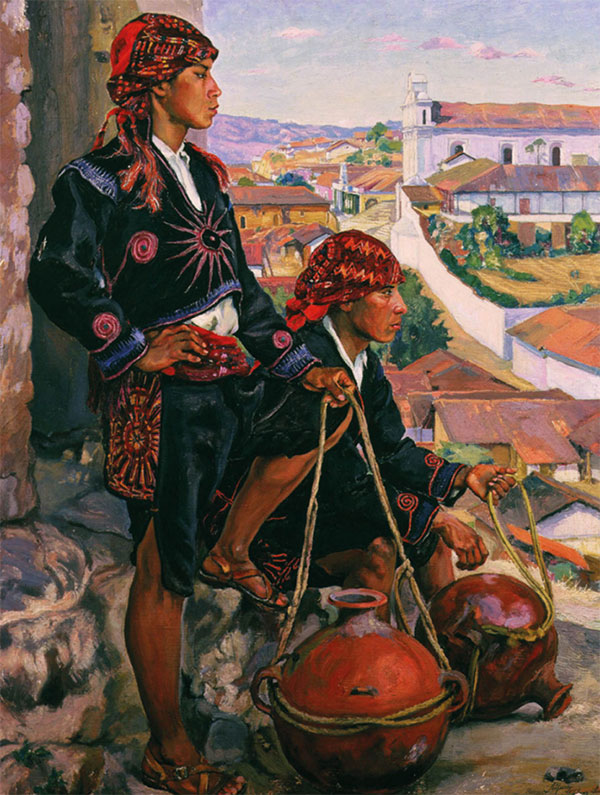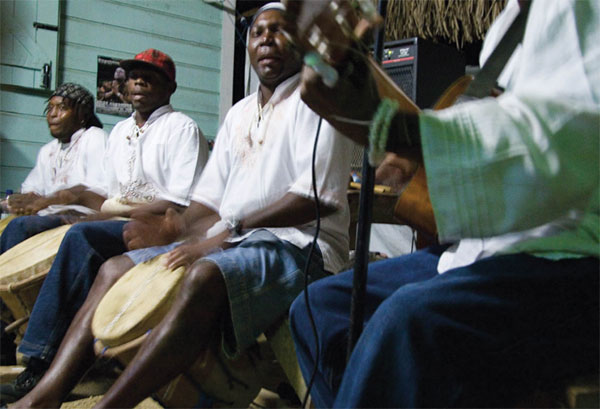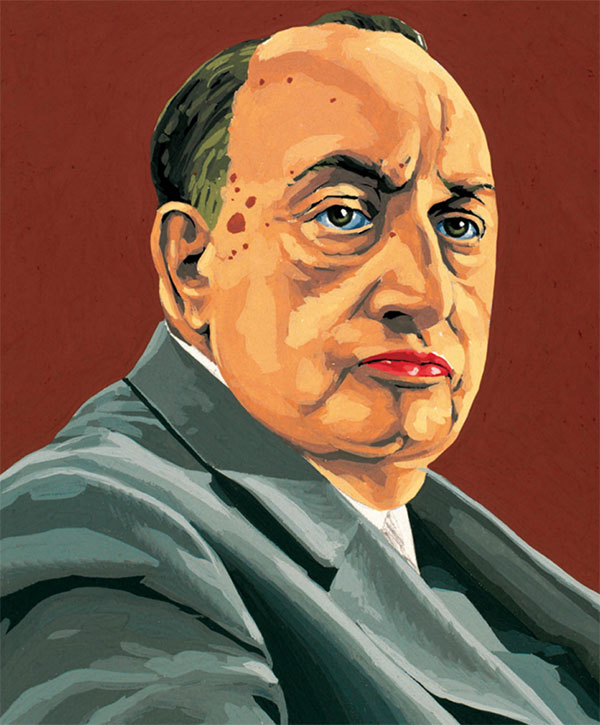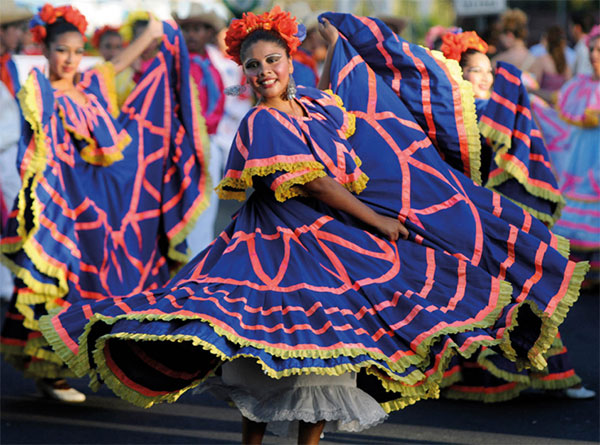BORN AGAIN
The strength of Evangelical churches was reinforced when General Efraín Ríos Montt came to power in Guatemala. Montt, who had become a born-again Christian in the 1970s, was the first Protestant president of Guatemala. Although condemned for the vicious counter-insurgency war that he fought in the countryside, his stern, uncompromising message of bringing law and order to a godless society won him a substantial political following. This support continued in the 1990s as his Republican Front of Guatemala (FRG) won the 1999 elections. However, the disastrous term of office that followed effectively ended the Montt myth and in 2012 he was charged with genocide.

Water carriers, Chichicastenango, Guatemala.
Dagli Orti/REX/Shutterstock
ARTS, MUSIC, AND DANCE
Whether its reggaetón or calypso, salsa or cumbia, Modernismo or Vanguardia, the vivid culture of Central America is a part of everyday life.
As in the rest of Latin America, art, literature, and music are fundamental parts of everyday life. Popular Latin music dominates the airwaves here, not to mention the inside of buses and taxis. Few Central Americans are shy about blasting reggaetón or cumbia into the street at decibel levels that humans in other parts of the world deem offensive. In each country, mainstream forms of salsa, mariachi, reggae, and calypso take on a new life. And in the other cultural forms, while few of the art and stories from the days before European arrival remain, post-conquest artistic expression has proved integral to making sense of the often-tumultuous political system.
All around the region, distinct forms of art have been created by and adapted to Central America’s diverse cultures and landscapes. In Panama, salsa and reggae have taken on new life, while on the rural coasts of Belize and Honduras, traditional Garífuna music has been modernized and exported to a mainstream audience. In Guatemala, the Maya have their own Bible and the literary movement of Modernismo found its origins. In the world of visual arts, the landscape – displayed in all its glory – has made its way to the fore, idealizing a simple life amidst the stunning natural surroundings of the countryside, even as civil wars and corruption raged in the cities.
Early writings
As Pre-Columbian cultures were primarily oral, few of their stories have survived post conquest. While the Aztecs and Mayans produced elaborate codices, most mythological and religious beliefs were recorded by Europeans, such as with the historical narratives of the Post Classic K’iche’ kingdom, known as Popol Vuh, sometimes called the Mayan Bible. Considered one of the most significant works of Guatemalan literature, Popol Vuh is a collection of Mayan stories and legends, aimed at preserving Mayan traditions. The first known text dates to the 16th century, though it wasn’t translated into Spanish until the beginning of the 18th century by the Dominican priest, Francisco Ximénez. There’s no other work as integral to the understanding of the culture of Pre-Columbian America as the Popol Vuh.

Garifuna Punta rock drummers in Dangriga, Belize.
Corrie Wingate/Apa Publications
During the colonial period, Central American countries were centers of European culture and literary activity flourished. There were poetic contests, theater, public recitations, and literary gatherings like those that would be found in European villages and cities. This era saw the first Central American authors writing in Spanish. Important writers included the region’s first playwright, Sor Juana de Maldonado, and the Guatemalan poet and Jesuit, Rafael Landívar. In Nicaragua, the satirical drama El Güegüense, written by an anonymous author, is a folkloric masterpiece combining music, dance, and theater.
Modern literature
In the late 19th century, a poetic movement called Modernismo materialized. It blended three European forms: Romanticism, Symbolism, and Parnassianism. Félix Rubén García Sarmiento, better known as Rubén Darío, was a Nicaraguan poet born in 1862. He’s considered the father of the Spanish-American literary movement of Modernism, and his works had a great influence in the Spanish literature of the 20th century.

Miguel Angel Asturias Rosales.
Central American literature was strongly influenced by the political situations in each country during the 20th century, and many works were written by authors and poets who were in exile from their respective countries. In the late 1920s, the Vanguardia literary movement emerged in Granada, Nicaragua, led by the poet José Coronel Urtecho. Modeled after European movements like Surrealism, Vanguardia’s aim was to attract the public’s attention through artistic expression, scandal, and aggressive criticism via confrontational themes. One of the most important writers in this period was the Guatemalan novelist Miguel Ángel Asturias, author of El Señor Presidente and Hombres de Maíz. He won the Nobel Prize for Literature in 1967.
Dance
To understand the evolution of musical and dance forms on the subcontinent is to attempt to fathom the tremendous demographic upheaval that took place over 500 years. The richness and diversity of Latin music reflects the many colonizing and colonized forces present over the centuries. Along with native elements, Africa, Europe and the United States all had a hand in the shaping of this magical music. Music grew from a brutal and loveless relationship, out of enslaved Indigenous people and Africans, European settlers, and colonial power brokers. Often oceans away from their homelands, these early inhabitants all had their music and dances. These were a way of remembering home and identity in an uncertain landscape. Thrown together in an ethnic melting pot, many traditions were either discarded or bonded together. Out of this struggle was born regional and national musical traditions that represent different colonial experiences and development.
Despite his given name, Felix Ruben Garcia Sarmiento, Darío started using his pen name at the age of 14. The name was adopted from a great grandfather.
Songs of struggle
Used by dictatorial powers as a propaganda tool, traditional music has, nevertheless, also been a useful source of social revolution and protest. The Nueva Canción (New Song) movement that emerged in Chile in the 1960s and 1970s put music at the forefront of the struggle all over Latin America. Nueva Canción was designed to voice the struggle and suffering of those with no lyrical accompaniment – but this has changed recently. The music is now accompanied by ballads sung most often in indigenous languages or in Spanish. These plaintive yet raucous songs record the daily lives, romances, and ribald interludes of rural indigenous communities. In Nicaragua, Nueva Canción musicians were credited with transmitting social and political messages, which helped aid the populace during the Sandinista revolution.
A spicy mix
Arguably the most international of all Latin American rhythms is what we now call salsa. The term itself is really nothing more than a marketing ploy adopted by the US music industry in the late 1960s, which assumed that people could not cope with the many different types of music Latin America had to offer. Son, mambo, guaracha, and many other styles were lumped together so that they could be easily packaged for consumption. Salsa means ‘sauce’ and the name was inspired by many musicians who would scream ‘Salsa!’ at a pulsating audience to excite them even further. This artificial grouping of many different styles means that most discussions about the origin of salsa become as hot and spicy as the dancing the music inspires. Most unbiased opinion, however, takes the view that today’s salsa is really a jazzed-up version of son, whose origins date back to eastern Cuba in the 1880s.

A dance troupe in the Joy of Life carnival, Managua, Nicaragua.
Son intermingled African rhythms with Spanish verse forms, and its early means of expression were drums, maracas, Cuban tres guitar, and claves or sticks tapping out the beat. The beat is syncopated and loaded with polyrhythms of regular pulses provided by the clave (two sticks that beat at a 2–3 or 3–2 tempo), the campana (cowbell), and accents that are offbeat (piano, bass, and brass). This is all useful to know if you want to blame your partner for messing up when he or she is clearly the better dancer. If salsa means sauce, then the musical ingredients in these complex arrangements need a master chef to work with them. As music is food for the soul to Latin Americans, culinary references in the lyrics are compulsory.